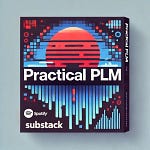We have arrived at the last chapter of the book in our video podcast series! It's one thing to read a book, it's another to apply the concepts to your work daily and discuss those with someone else! We both agree it has helped us grow our practical experience with Product Lifecycle Management (PLM).
In the episode we ask each other what got us on this year long journey to start a podcast on PLM? For me, it was the challenge of managing 20 similar product installations on a large oil and gas processing plant installation. The 20 products were all similar, but not all the same - this meant many hours of administrative work tracking down which of the 20 products had upgrade; some with upgrade A, some with upgrade B, some had something different! Frustrated I thought to myself, "surely with the technology we have today there is a better way to do this!" For Luke it was also, in a sense, out of frustration. Coming from his sales background and moving into an engineering role he was often frustrated at the gaps in information that sales would bring to the engineering team. This would cause delays, additional work for the engineers and result in a lower quality solution for the customer. PLM is the better way to do it, but as you will see in this last chapter, there is still so much to do.
Chapter 15 “Virtually Unfinished”
People, processes and technology. If you have been following along this series, those words will mean a lot to you as they do to us. Here are a few short thoughts on them:
People: getting people aligned with a vision is critical. People will need education (understanding why), not just training on the journey. Organisational change is a significant undertaking!
Processes: Not everything is a process. There are also practices (and arts). Practices are a critical part of all businesses.
Technology: The easiest to get excited about, especially with the rise of AI and how it will help connect the silos in companies and reduce wasted time and resources.
This topic of PLM remains unfinished, even after 14 years since the book was published, as the area is still evolving to help businesses add value to their customers. In reflecting on the book, we both shared what vision we have come away with. I have a vision of how an engineering company could be run in a way that connects what is happening with the welding on the shop floor, to the discussion sales is having with the client to the practices of how information is shared in the company. For Luke, he has a vision of "engineering work without the admin." Without having to copy long lists from Excel or do tedious documentation work.
We hope this journey through PLM, and by extension digital twins, has been of benefit to you. We have certainly learned more than we expected!











